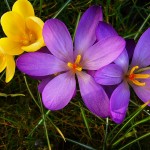 One small white rose glowed in the sunlight, floating in a dark-green sea. I was mesmerized. This could not be. Yet there it bloomed, staring at me, laughing.
One small white rose glowed in the sunlight, floating in a dark-green sea. I was mesmerized. This could not be. Yet there it bloomed, staring at me, laughing.
This went on for days – no other flowers in the vast hedge, just this one, living its full cycle before the others even began. I wondered about sunbeam collisions in that one spot, water flowing in new directions from last fall’s pruning. I also enjoyed supposing a bit of faerie magic. Eventually a second little rose joined in, fresh and bursting, while the forerunner’s petals had already begun to shrink and fall.
I started seeing everything this way: a flowering shrub half-under the eave was divided, sun-exposed branches blooming dark vermilion while shadowed branches remained plain green – though I knew the pokey ones would blossom in time. They’d all be plain green again by autumn.
As I write this, I remember a lawn where crocus bulbs were planted to spell out SPRING in letters three feet tall. Invisible in winter, they burst forth each year in all colors at the right moment for them – not the calendar – sometimes popping out from a blanket of snow.
These visions bring to mind a Rilke phrase echoing through the “blooming buzzing confusion” about the coming Spring Equinox: in Letters to a Young Poet, Rilke mentions the “sadness of spring” – not an idea I wanted to lead with, but something that was changed by that one white rose.
In context, Rilke was writing to a sensitive young person dealing with melancholy, frustration, exhaustion, and disappointment. In such a state, seeing Nature dance happily full of beauty and fruit could indeed generate sadness – especially if the whole exercise seemed pointless: it was all going to die again soon.
While letting this phrase sink in, I saw a graph from Ervin László’s work on how change happens: the devolution of “the old” into chaos, from which “the new” emerges – and eventually becomes the new “old,” which decays into chaos, on and on. A vital inner shift happened when I took it personally, seeing this process not just as cultural phenomena, not as biological life-cycles (new people versus old people) – but as a picture of how different selves (identities, roles, enthusiasms) in a single lifetime arise and decline, with chaos in between, always with the chance of something new emerging (ideally, better than before).
That concept morphed into remembering that several role-altering enthusiasms operate all at once in a single life (a culture of one), and each expression is in a different phase, a different season. Some identities and roles bloom and disappear, maybe to express again some other time in some other form, maybe hybridized with something else from the environment, maybe far away via seeds carried on the wind or in the bodies of birds. Some keep reappearing in almost the same way, in the same place, perennially. Some are evergreen. Some are one-time occasions, but the ground is changed by their having existed, however briefly, whether seeds propagate or not.
So it’s all seasons, all the time: springtime anytime for new ventures and transformed selves, summer for long-standing ones, autumn for identities ready to rest, and winter for expressions that can be no more – though the liquid light of memory lets them bloom forever, timeless, griefless. What sweet chaos.
Photo credit: soultga via stockxchange